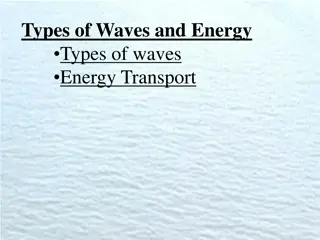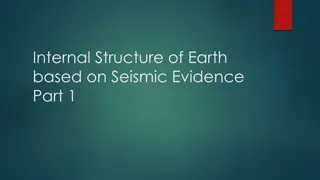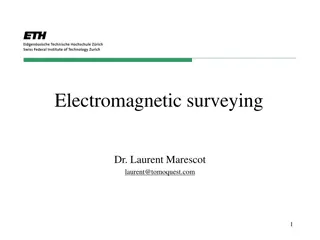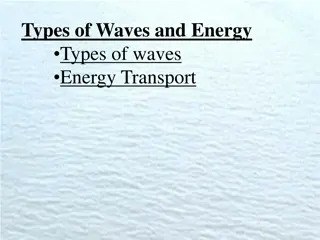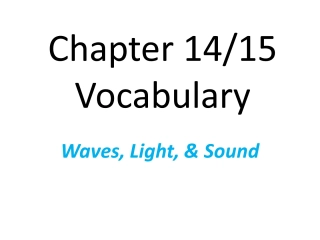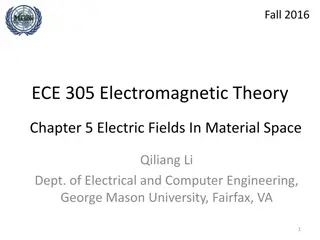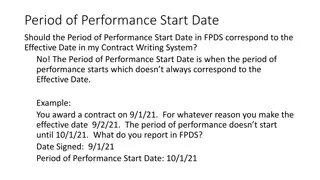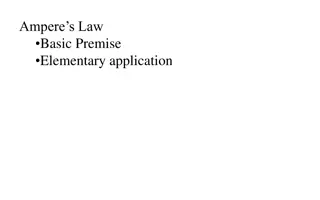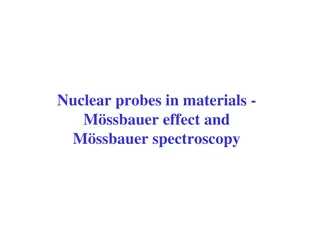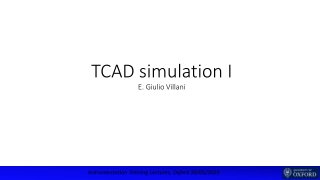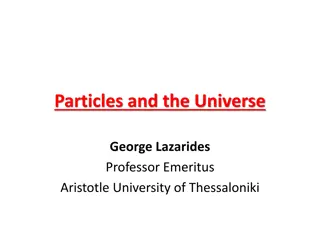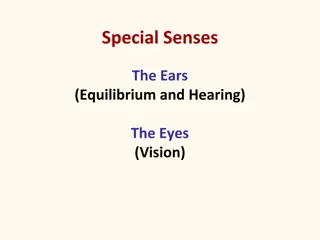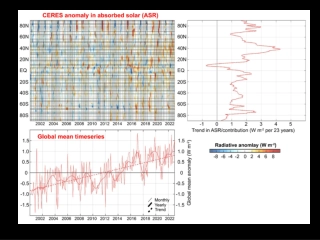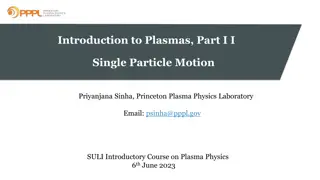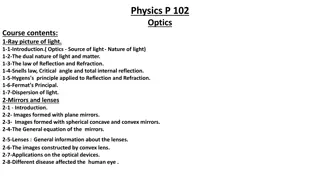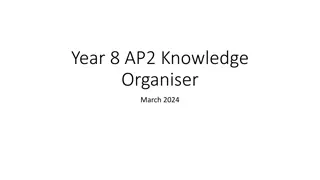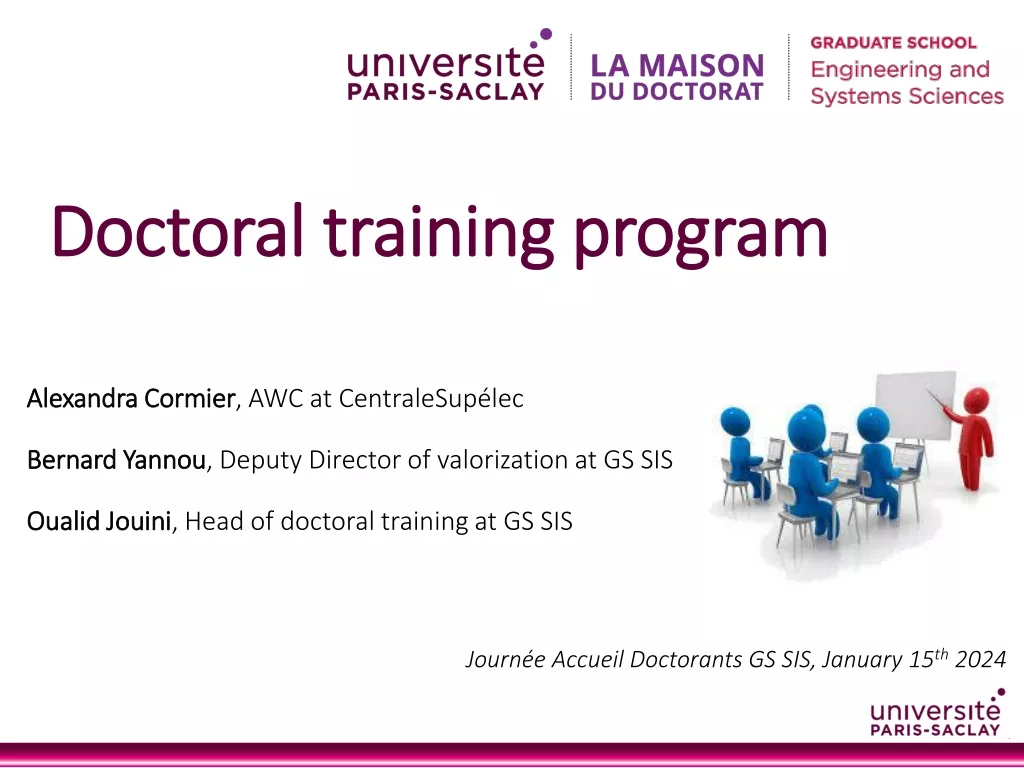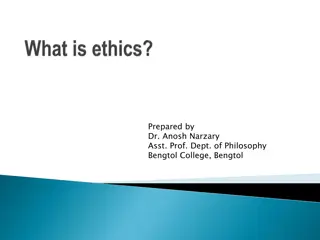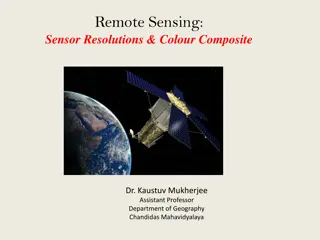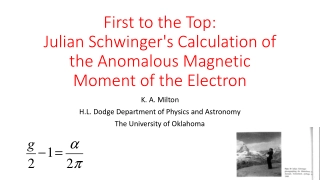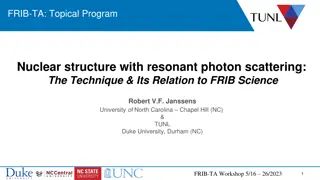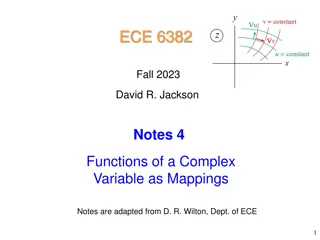Understanding Reflection and Transmission of Plane Waves in Electromagnetic Fields
The notes discuss the reflection and transmission of plane waves, wave vectors, fundamental polarizations (TMz and TEz), and boundary conditions at material interfaces. It covers the behavior of different types of plane waves, their interactions, and the conditions that govern their propagation through materials. Key concepts include wave variations, Poynting vector, field continuity, and boundary conditions.
Understanding Reflection and Transmission of Plane Waves in Electromagnetic Fields
PowerPoint presentation about 'Understanding Reflection and Transmission of Plane Waves in Electromagnetic Fields'. This presentation describes the topic on The notes discuss the reflection and transmission of plane waves, wave vectors, fundamental polarizations (TMz and TEz), and boundary conditions at material interfaces. It covers the behavior of different types of plane waves, their interactions, and the conditions that govern their propagation through materials. Key concepts include wave variations, Poynting vector, field continuity, and boundary conditions.. Download this presentation absolutely free.
Presentation Transcript
ECE 3317 Applied Electromagnetic Waves Prof. David R. Jackson Fall 2023 Notes 18 Reflection and Transmission of Plane Waves 1
General Plane Wave p Consider a plane wave traveling in an arbitrary direction in space. We call the axis of propagation z . = + + xx yy zz r z ( ) Denote: , , x y z z ( + ) = jkz = sin cos x p e p ( ) sin sin y r (This function tells us how the plane wave varies in space.) ( ) + cos z y (direction of power flow) x = z r p ( ) = + + xx yy p zz ( ) ( ) ( ) = + + x p x y p y z p z so ( ) ( ) ( ) = sin cos + sin sin + cos z x y z 2
General Plane Wave (cont.) = + + xx yy zz r Hence z ( ) , , x y z z ( ) p j k x k y k z + + = = jkz e e x y z r = = = sin cos sin sin k k k k x y y cos k k x z Note: ( ) + + = + + 2 x 2 y 2 z 2 2 2 2 2 2 sin cos sin cos k k k k k or + + = 2 x 2 y 2 z 2 k k k k (wavenumber equation) 3
General Plane Wave (cont.) = + + xx yy zz r z We define the wavevector: x k xk ( ) , , x y z z + + yk z k k y z r = = = sin cos sin sin k k k k x y y cos k k z x ( ) j k x k y k z + + = = jk r e e x y z ( ) ( ) ( ) = sin cos + sin sin + Recall: p x y z cos = k k p The k vector tells us which direction the wave is traveling in. 4
TMz and TEz Plane Waves There are two fundamental polarizations possible. = = TM : , E E H H Transverse Magnetic (TMz) Hz = 0 Transverse Electric (TEz) Ez = 0 z = = TE : , E E H H z z z S S TE TM H z z H E E y y x x Note:The word transverse means perpendicular to. 5
Reflection and Transmission As we will show, each type of plane wave (TEzand TMz) reflects differently (and independently) from a material interface. Reflected Incident i r #1 x t #2 Transmitted z Note: We assume that the Poynting vector of the incident plane wave lies in the xz plane ( =0). This is called the plane of incidence. There is then no variation of the fields in the y direction (ky = 0). 6
Boundary Conditions Here we review the boundary conditions at an interface (from ECE 3318). General BCs: n s , sJ ( ) ) 1 1 = = = n D D ++++ 1 2 s ( B n 0 E E 1 2 , ( ) n 0 = B 2 2 1 2 H ( ) n H J 1 2 s Note: The unit normal points towards region 1. No sources on interface: = = n E n H n E H 1 2 n D n 1 2 = = n D The tangential electric and magnetic fields are continuous. n B n B 1 2 (The normal electric and magnetic flux densities are also continuous.) 1 2 7
Reflection at Interface Assume that the Poynting vector of the incident plane wave lies in the xz plane ( =0). This is called the plane of incidence. Reflected Incident i r #1 x t #2 Transmitted z We first consider the (x,z) variation of the fields. (We will worry about the polarization later.) E e jk x jk z + = E e jk x jk z E e jk x jk z = = r i t E E E xr zr xi zi xt zt 0 i 0 0 r t Note: The plus sign for the exponent term in the reflected wave is chosen because this wave is traveling in the negative z direction. 8
Reflection at Interface (cont.) Phase matching condition: = = k k k xi xr xt Reflected Incident i r ( ) #1 k k , x xr x t k #2 xt Transmitted z This follows from the fact that the fields must match everywhere at the interface (z = 0). ( ) ( ) ( ) E e E e E e = = = jk x jk x jk x i t r ,0 E x ,0 ,0 E x E x xi xt xr 0 0 0 r t i 9
Law of Reflection Reflected Incident i r = #1 k k xi xr x t #2 (This comes from the first part of the phase matching condition.) Transmitted z = = = = = = sin k k k sin k k k 1 xr r 1 xi i 0 0 Incident and reflected waves: yr yi cos k k cos k k 1 zr r 1 zi i = = sin sin k k Law of reflection i r 1 1 i r 10
Snells Law = Reflected Incident k k xi xt i r #1 x (This comes from the second part of the phase matching condition.) t #2 Transmitted z Incident and transmitted waves: = = = = = = sin sin k k k k k k 2 1 xt t xi i We define the index of refraction: 0 0 yi yt = = = / / n k i = k 1,2 cos cos k k k k 0 0 0 i i i i ri ri 2 1 zt t zi i = = sin sin n n sin sin k k Snell's law 1 2 i t 1 2 i t Note: The wave is bent towards the normal (z axis) when entering a more optically "dense" region (a higher index of refraction). 11
Snells Law (cont.) The bending of light (or EM waves in general) is called refraction. Reflected Acrylic block Normal Incident Transmitted http://en.wikipedia.org/wiki/Refraction 12
Example i = o 45 Given: Reflected Incident Find the transmitted angle. i r #1 Air x t Water #2 = sin sin n n 1 2 i t r = 1.7689 = r 1.7689 2 Transmitted = 1sin 1.7689sin z i t Note that in going from a less dense to a more dense medium, the wavevector is bent towards the normal. t = o 32.1 Note: If the wave is incident from the water region at an incident angle of 32.1o, the wave will exit into the air region at an angle of 45o. Note: At microwave frequencies and below, the relative permittivity of pure water is about 81. At optical frequencies it is about 1.7689. 13
Critical Angle The wave is incident from a more dense region onto a less dense region. n n i c Reflected Incident i r #1 1 2 x t #2 Transmitted = sin sin n n 1 2 i t z n n = sin sin 1 = t i i c 2 Reflected Incident i r t = o 90 At the critical angle: #1 x n n ( ) t = o sin 90 sin 1 t = o #2 90 c Transmitted 2 z n n = 1 sin 2 c = = = = = : sin k k k k k 1 2 2 i c xi xr xt t 14
Critical Angle (cont.) Example Find the critical angle. r = 1.7689 Water 1 Reflected c r Incident n n #1 = 1 sin 2 x c 1 #2 Air 1 Transmitted = 1 sin 1.7689 z c = o 48.75 15
Critical Angle (cont.) Example: "fish-eye" effect c = o 48.75 Air r = 1.7689 Water c The critical angle explains the fish eye effect that you can observe in a swimming pool. A fish can see everything above the water by only looking no farther than 49o from the vertical! 16
Critical Angle (cont.) At the critical angle: = = = = sin k k k k k = 2 2 xi xr xt t i c Reflected i r Incident = 2 2 2 xt k k k #1 zt x t = = 2 2 2 2 k k #2 t = o 90 Transmitted 0 z There is no vertical variation of the field in the less-dense (transmitted) region. There are still fields in the less dense region, however. 17
Critical Angle (cont.) Beyond the critical angle: i c i c k k Reflected Incident 2 xi i r ( ) = = = sin90o sin sin k k k k k #1 1 1 2 2 xi i c x #2 = 2 2 2 xt k k k Exponential decay zt = 2 2 2 xi k k z = 2 xi 2 2 j k k = 2 2 2 2 sin j k k 1 i There is an exponential decay of the field in the vertical direction in the less-dense region. = = 2 1 2 2 2 sin jk j n n 0 i zt = ( ) ( ) ( ) 2 1 2 2 2 sin k n n + j k x k z j k x tx z = ztz , e e e xt zt xt 0 zt i 18
Critical Angle (cont.) Beyond the critical angle: i c Reflected Incident i r #1 x #2 ( ) Re S z The power flows completely horizontally in the lower region. No power crosses the boundary and enters into the less dense region. This must be true from conservation of energy, since the field decays exponentially in the lossless region 2. 19
Exotic Materials Artificial metamaterials that have been designed that have exotic permittivity and/or permeability performance. https://en.wikipedia.org/wiki/Metamaterial Negative index metamaterial array configuration, which was constructed of copper split-ring resonators and wires mounted on interlocking sheets of fiberglass circuit board. The total array consists of 3 by 20 20 unit cells with overall dimensions of 10 100 100 mm. 0 0 r r (over a certain bandwidth of operation) 20
Exotic Materials (cont.) The Duke cloaking device masks an object at one microwave frequency. Image courtesy Dr. David R. Smith. Cloaking of objects is one area of research in metamaterials. https://en.wikipedia.org/wiki/Metamaterial_cloaking 21
TEz Reflection i E i H i r #1 TE x t T #2 TE z Note that the electric field vector is in the y direction. (The wave is polarized perpendicular to the plane of incidence.) 22
TEz Reflection (cont.) Incident Wave = i E i r i H yE e jk x jk z = i E xi zi 0 i r #1 TE x Reflected Wave t T #2 TE E e jk x jk z + = r y E xr zr 0 TE z Transmitted Wave yT E e jk x jk z = t E xt zt Incident Wave Vector TE 0 i k = 1cos k k = + xk z k zi i xi zi Reflected Wave Vector where = = 1cos k k xk zk k = Reflection Coefficient zr r r xr z r TE = Transmission Coefficient T Transmitted Wave Vector TE = + xk zk k = 2cos k k t xt z t zt t = = = 1sin k k k k xi xr xt i 23
TEz Reflection (cont.) Recall that the tangential component of the electric field must be continuous at an interface. i E i H i r #1 TE x t Boundary condition at z = 0: T #2 TE i y r y t y + = E E E z jk x jk z jk x jk z + jk x jk z + = E e E e T E e xi z i x r zr xt z t 0 T E 0 T E 0 z = 0 e j k x j k x jk x + = E e E e T E xi xr xt 0 TE 0 TE k = 0 = k k xi xr xt + = E E T E 0 TE 0 TE 0 Divide by E 0 + = 1 T TE T E 24
TEz Reflection (cont.) We now look at the magnetic fields. i E i H i r #1 = E j H TE x t T #2 TE 1 = H E j z + ( ) j k x k z i = yE e E ( ) j k x k z r xi zi = y E E e xr zr 0 TE 0 E E + ( ) j k x k z i ( ) j k x k z r 0 TE 0 = + = + + xk xk z k z k ( ) ( ) H e H e xr zr xi zi zr xr zi xi 1 1 + = ( ) j k x k z t yT E e E xt zt T E TE xk 0 + = + ( ) j k x k z t z k ( ) TE 0 H e xt zt zt xt 2 25
TEz Reflection (cont.) i E Recall that the tangential component of the magnetic field must be continuous at an interface (no surface currents). i H i r #1 TE x t T #2 Boundary condition at z = 0: TE i x r x t x + = H H H z Hence, we have: k k T k TE z i z t TE z r + = 1 1 2 26
TEz Reflection (cont.) i E i H i r #1 TE Enforcing both boundary conditions, we have: x t T #2 TE z + 1 =T TE T E The solution is: k k T k TE zi z t T E zr = + 2 1 1 1 2 k k zt zi = TE 2 1 k k zt zi = + 1 T TE TE 27
TEz Reflection (cont.) Transmission Line Analogy Incident i E i H TE 1 Z i r #1 TE TE x t T #2 TE T TE z TE 2 Z TE 2 TE 2 TE 1 TE 1 Z + Z Z Z = TE TE 1 Z TE 2 1 2 = = Z k k zi zt = + 1 T TE TE 28
TMz Reflection i E i H i r #1 TM x t T #2 TM z Note that the electric field vector is in the xz plane. (The wave is polarized parallel to the plane of incidence.) Word of caution: The notation used for the reflection coefficient in the TMz case is different from what is in the Shen & Kong book. (We use reflection coefficient to represent the reflection of the tangential electric field, not the tangential magnetic field.) 29
TMz Reflection (cont.) Incident Wave i E i = - H jk x jk z i yH H e 1 xi zi 0 k i r #1 zi TM x Reflected Wave t T #2 TM ( ) jk x jk z + = r y H e H 1 xr zr 0 TM k zr z Transmitted Wave Incident Wave Vector jk x jk z = t yT H H e 2 xt zt i k TM 0 k = + xk z k zt xi zi Reflected Wave Vector where = xk zk k r xr z r = Reflection Coefficient TE Transmitted Wave Vector = Transmission Coefficient T TE = + xk zk k t xt z t 30
TMz Reflection (cont.) We now look at the electric fields. i E i H i r #1 = H j E TM x t T #2 TM 1 = E H j z = - jk x jk z i yH ( ) H e 1 jk x jk z + = xi zi - r y H e H 1 x r zr 0 k 0 TM k zi zr + = ( ) j k x k z i x z k ( / ) E k H e x k z = + ( ) j k r xi zi x z k ( / ) E k H e xr zr 0 xi zi TM 0 xr z r Note that TM is the reflection coefficient for the tangential electric field (Ex). jk x jk z = t yT H H e 2 xt zt TM 0 k zt + = ( ) j k x k z t x z k ( / ) E k T H e xt zt TM 0 xt zt 31
TMz Reflection (cont.) Boundary conditions: i E i y r y t y + = H H H i H i r #1 i x r x t x + = E E E TM x t T #2 TM Enforcing both boundary conditions, we have z The solution is: = 1 1 2 TM T T M k k k + k k z i z r zt zt zi + 1 =T 2 1 = TM T M TM k k zt zi 2 1 = + 1 TM T TM 32
TMz Reflection (cont.) Transmission Line Analogy Incident i E i H TM 1 Z i r #1 TM TM x t T #2 TM T TM z TM 2 Z TM 2 TM 2 TM 1 TM 1 Z + Z Z Z = TM k k TM 1 Z TM 2 zi zt = = Z 1 2 = + 1 TM T TM 33
TMz Reflection (cont.) Summary of Transmission Line Modeling Equations Incident k m = TE m 1,2 TM m m zm = = Z Z k Z zm m 1 Reflected Incident i r #1 T x t Z #2 2 Transmitted z ( ) 2 = = = = 2 2 xi 2 sin cos k k k k k k k 1 1 1 1 1 z zi i i ( ) ( ) 2 2 = = = = = = 2 2 2 xt 2 2 2 xi ) 2 2 2 2 sin sin cos k k k k k k k k k k k 2 1 2 2 z zt i t t ( ( ) = Recall: = k k Recall: sin sin k k xt xi 1 2 i t 34
Power Reflection i E i E i H i H i r i r #1 #1 TM TE x x t t T T #2 #2 TM TE z z 2 = % powerreflected 100 ) ( 2 = % powertransmitted 100 1 = or TM TE 35
Power Reflection Beyond Critical Angle i c Incident Reflected i r #1 x #2 = or TM TE z 2 = % powerreflected 100 k TM 2 zt = Z + Z Z Z Z 2 1 = 2 = j k 2= Z imaginary ( reactive load ) zt zt 2 1 TE 2= 2 Z k zt All of the incident power is reflected. = 1 36
Example = = 1 1 i Given: 1 r r #1 i = 30 1 r x t T = = 2 1 #2 2 r 2 r z Find: % power reflected and transmitted for a TMz wave % power reflected and transmitted for a TEz wave Recall: = sin sin n n Snell s law: 1 2 2sin i t t = 20.70 n = t i ri ri o 1sin30 37
Example (cont.) + TM 2 TM 2 TM 1 TM 1 Z Z Z Z = First look at the TMz case: TM cos cos k k = = TM 1 cos Z = = = 2 2 TM 2 t 2 zt t Z 0 i 2 2 2 327.1 [ ] = = cos cos 0 2 t t 2 2 r TM 2 TM 2 TM 1 TM 1 Z + Z Z Z = 376.7303cos 20.70 2 249.8 [ ( ) TM = o = + = 1 TM T ] TM Note that these values do not depend on frequency for a lossless material! = 0.1339 TM = 0.8661 T TM 38
Example (cont.) Summary for TMz Case 2 = % powerreflected 100 ) ( 2 = % powertransmitted 100 1 = TM 0.1339 = % % 1.79 = powerreflected powertransmitted 98.21 39
Example (cont.) + TE 2 TE 2 TE 1 TE 1 Z Z Z Z = Next, look at the TEz case: TE = = TE 1 0sec 436.2 [ ] Z = = TE 2 2 2 cos Z i k zt 2 2 t 1 = = sec 0 2 t cos TE 2 TE 2 TE 1 TE 1 Z 2 t 2 + r Z Z Z = = 285.5 [ ] TE = + 1 T TE TE = 0.2088 Note that these values do not depend on frequency for a lossless material! TE = 0.7912 T TE 40
Example (cont.) Summary for TEz Case 2 = % powerreflected 100 ) ( 2 = % powertransmitted 100 1 = 0.2088 = % % 4.36 = powerreflected powertransmitted 95.64 41
Example The lower region is now lossy. Given: i = f = 30 = = 1 1 i 1 r r 1GHz #1 1 r x t T #2 = = = 81 1 4 [S/m] 2 r Sea water 2 r x 2 Find: % power reflected and transmitted for a TMz wave % power reflected and transmitted for a TEz wave 42
Example (cont.) Given: = = 1 1 i r 1 r i = f = #1 30 1 r x 1GHz t T #2 = = = 81 1 4 [S/m] 2 r Sea water 2 r x 2 ( ) = = = = 81 71.90 j j 2 j j 2 2 2 2 2 2 0 2 rc r c r 0 We avoid using Snell's law now, since it will give us a complex angle t in region 2! ( ) = Recall: sin sin n n 1 2 i t Recommendation: Work with the wavenumber kzt only (avoid using t). 43
Example (cont.) + TM 2 TM 2 TM 1 TM Z Z Z Z = First look at the TMz case: TM 1 = 0cos TM 1 Z 2 2 2 xt 2 2 2 xi 2 2 2 2 sin k k k k k k i k = = = = 1 i TM 2 zt Z 2 2 2 2 c c c c = TM 1 326.3 [ Z ] 2 2 2 sin = Note: (This is difficult to work with!) 2cos k k = 2 2 1 1 c i zt t 2 c 2 sin = 0 2 0 1 c i TM 2 TM 2 TM 1 TM 1 Z + Z Z Z 2 c = TM 2 sin = 2 1 rc r i ( ) = 81 71.90 j 0 2 rc 2 rc (at 1.0 [GHz]) = + 1 TM T 2 sin TM = 2 rc i 0 2 rc ( ) The reflection coefficient now depends on frequency. = + TM 2 33.82 12.82 [ ] Z j ( ) 0.8099 = + 0.0644 j TM 44
Example (cont.) Summary for TMz Case 2 = % powerreflected 100 ) ( 2 = % powertransmitted 100 1 ( ) 0.8099 = + TM 0.0644 j = % % 66.0 = powerreflected powertransmitted 34.0 45
Example (cont.) + TE 2 TE 2 TE 1 TE 1 Z Z Z Z = Next, look at the TEz case: TE 0sec = TE 1 Z = = = = TE 2 Z 2 2 2 2 sin i k 2 2 2 xt 2 2 2 xi 2 2 2 2 k k k k k k zt 1 i = TE 1 435.0 [ ] Z = 2 2 2 2 sin 2 2 1 1 c i = 0 TE 2 TE 2 TE 1 TE 1 Z + Z Z Z 2 sin = 0 2 0 1 1 c i TE = 0 2 sin ( ) = 81 71.90 j = + 2 1 rc r i 1 T 2 rc TE TE 1 (at 1.0 [GHz]) = 0 2 sin 2 rc i The reflection coefficient now depends on frequency. ( ) = + TE 2 33.86 12.89 Z j ( ) = + 0.8542 0.0510 j TE 46
Example (cont.) Summary for TEz Case 2 = % powerreflected 100 ) ( 2 = % powertransmitted 100 1 ( ) = + 0.8542 0.0510 j = % % 73.2 = powerreflected powertransmitted 26.8 47
Example (cont.) Now consider an incident RHCP Wave RHCP Wave = = 1 1 i r Given: 1 r #1 i = f = 1 r 30 x t T 1GHz #2 = = = 81 1 4 [S/m] 2 r Sea water 2 r x 2 Assume incident power density is 1 [W/m2]. 0.5 W/m = = TM TE 2 P P i i ( ) 2 2 = = 0.5 0.8099 + = TM r P TM 2 0.0644 0.3300 W/m P j TM i ( ) 2 2 = = + = TE r P TE 2 0.5 0.8542 0.0510 0.3661 W/m P j TE i The reflected power is 69.6% of the incident power The reflected wave has 47.4% of its power in the TM polarization. 48
Brewster Angle Assume TMz polarization Assume lossless regions i E i H i r #1 TM x t T #2 TM z TM 2 TM 2 TM 1 TM 1 Z + Z Z Z = TM 2 TM 1 Z = = 0 Z Set TM TM Matched load! 49
Brewster Angle (cont.) k k k k TM 2 TM 1 Z zt 2 z = = zi 1 z = = Z TM 2 TM 1 Z = Z 2 2 1 1 Hence, we have: ) ( k k zi zt = = = 2 2 2 2 cos sin k k k k 2 1 zt t i 1 2 2 2 2 1 2 sin k k cos k = i 1 i 1 2 2 2 2 2 2 2 (1 sin ) sin k k k = 1 1 i i 2 1 2 2 50



